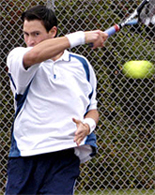Winning Pretty Part 2:
Origins of Technique
Chris Lewit
Where does technique originate? There are no ideal "techniques" when a sport is created. How could there be? If no one is playing the sport there is no one to define what "technique" should be. It's a blank slate.
When athletes first started to play tennis and compete they had to rely on their own intuition, feelings, and results to guide them. Players also observed each other and intuitively developed skills to compete better. These skills--player developed and not coach driven--naturally formed the initial techniques of the "right" way to play tennis. Tennis, as first played on grass, was invented in the 1870s. The first Wimbledon championships were played in 1877. The first coaches in tennis were players themselves, analyzing what worked and forming a method of teaching those techniques to the next generations of players.
According to one researcher the first tennis instructional book was published in 1914. Others quickly followed. In the 1920s Bill Tilden published several influential books. But from the start there was no consensus. Some teachers advocated semi-open stance, others neutral stance. Some favored continental grips, others semi-western and even western.
The same researcher claims that from the beginning, even before 1900, players were already hitting buggy whip and straight arm forehands. . One early book stated that the key to winning tennis was topspin. The range of opinions often creatin acrimony and personal attacks.
Eventually, teaching organizations and national federations were formed. One major group advocated a classic method for all players. Another felt that technique was more up to individual coaches.

As generations of players come and go, innovative players come up with novel ways to hit the ball better, coaches take note, and the cycle continues. Over time the technical game has evolved into the modern forms we see today: explosive racquet speed, heavy topspin, and violent hip rotations creating angular, rotational force.
Court Surface
Court surface influences the experiences of a player and shapes their technical styles. Spanish players grow up on slow red clay and intuitively discover that topspin is very important to playing winning tennis on that surface.
Spanish players may gravitate toward using more open stances and more western grips to improve their acceleration and topspin, the way Sergi Bruguera did in the late 1980s and 1990s. Larger swing radiuses are typical in Spain because the players have more time to react due to the slow court surface and typically deeper court positioning on clay. American players tend to play on fast, hard courts. Their groundstroke techniques tend to favor more compact swings to compensate for having less time to react and to be able to take the ball earlier and on-the-rise. American players tend to use more conservative groundstroke grips to assist in hitting the ball on the rise.
There are always iconoclastic players who break from the traditions of their region and the influence of the court surface that they play on, but most players follow the norm. The most common surface of a country or region usually informs the judgment of players about what techniques win.
Equipment Technology
The evolution of tennis equipment--racquets, strings, and balls--has undoubtedly influenced the evolution of technical styles. Says John Yandell, "Tennis technique development has seen dramatic change over the past decades due to the different court surfaces internationally, the myriad ways to hold and swing the racquet,and especially the innovation in tennis equipment." Modern lightweight racquets can be swung violently and whipped through the hitting zone. Co-polyester strings allow players to take fast swings but also generate levels of topspin that were impossible in previous generations.
Slower tournament balls have also influenced the game style and shot selection of competitive players. These multivariate influences in tennis have triggered dramatic changes in technique--more than in any other popular world-wide sport.
The Form of Famous Players
Great players from different parts of the world influence philosophies and styles from region to region, and they influence how coaches and players see the optimal way to hit the ball and build technique. Young kids growing up often copy the technique of famous players in their region or country.
Coaches also copy those techniques and promulgate them to their students. In this manner, a country or region often develops a common style or technical approach practiced by a majority of its players.
In the US, for example, American players typically play predominantly on hard, fast courts and have an attacking style, take the ball early, and often have big serves. From John McEnroe and Jimmy Connors in the 1970s and 1980s, to Jimmy Arias, Pete Sampras, Andre Agassi, and Serena Williams in the 1980s and 1990s, to name a few, famous players from the US have influenced American kids, adults and coaches who have copied their techniques.
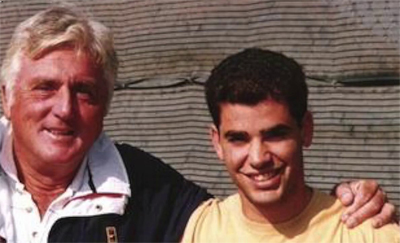
The United States is a big country with many different styles of coaching depending on the region, but has been shaped by coaching leaders like Rick Macci, Robert Lansdorp, Nick Bollettieri, and Steve Smith. In general the coaches in the US are technically oriented and focus a lot on grips and swings.
Successful American coaches like Rick Macci promote a technical style of player development, and he has legions of followers around the country who do the same. Steve Smith has many adherents who follow his technical and scientific approach based on the teachings of Vic Braden and other technicians like Welby Van Horn.
Each country and region of the world has their own unique technical story. In Spain, for example, charismatic players like Sergi Bruguera, Carlos Moya, Juan-Carlos Ferrero, Rafael Nadal and Carlos Alcaraz have had an enormous effect on the way technique is visualized in Spain by coaches and players who tend to imitate their swings and grips.
Spanish players are also known for their superior fitness and movement, fighting spirit, as well as powerful forehands, consistency, and topspin play. But they generally do not have dominant serves.
Alcaraz is a new mold of Spanish player with a bigger serve who combines an all-court style, touch, and creativity with the physicality, grit, and other important aspects of the typical Spanish game.
Bruguera and Alvarez
Lluis Bruguera, one of the founding fathers of the modern Spanish method and a major force in developing the Spanish philosophy of training, was heavily influenced by the style and technique of Bjorn Borg and the teaching methods of Harry Hopman, from Australia. WillamPato Alvarez was a legendary coach in Spain since the 1970s, who together with Lluis, developed important philosophies and principles that became part of a new Spanish method used by coaches across the country.
The RPT and the RFET, with a curriculum heavily influenced by the teachings of Lluis and Pato, are the coaching organizations that certify in the country and they shape how coaches view and approach building the games of Spanish players.
Modern technology has enhanced communication and the ability to share information, especially in the form of videos from around the world. Technical development used to be much more highly segmented by geographical region because players and coaches had only limited knowledge about how other regions were developing players, and this was learned mainly learned through physical travel.
Today, with social media and video sharing technologies, it's possible to keep abreast of technical trends and developmental approaches around the world at the push of a button on one's phone or computer. Therefore, techniques from one region can be quickly adopted by another, and players and coaches can copy new techniques created by other players or coaches far away from home, which is a relatively new phenomenon in technique development.
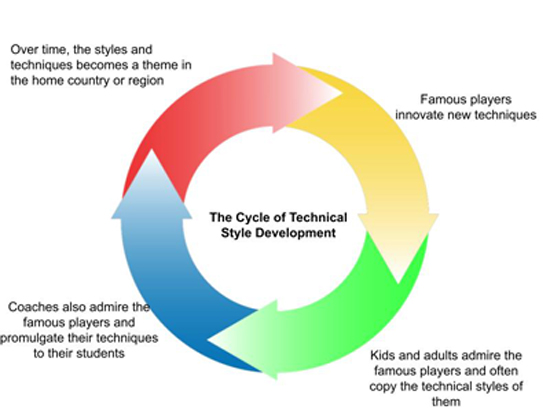
This technical cross-pollination would have been impossible or at least severely slowed in the decades before such technologies existed. For example, in the 1970s and 1980s, players and coaches from the US could not have known about the training methods in Spain or how Spanish players learned techniques except for traveling to Spain and observing Spanish players and coaches tournaments. Today you can still visit Spain and study coaching there, but individuals can also learn a tremendous amount about Spanish tennis via online sources, social media, and by video sharing.
Techniques have thus become more homogenized around the world because coaches and players are no longer operating in a vacuum, unaware of what the others are doing. The technique world is less segmented and fragmented today because of modern technology, which means at the pro level there are fewer examples of outlier techniques.. Sports science and biomechanical research also have also had a homogenizing effect on technique around the world as coaches in every country have access to the same research.
Borg and Arias
The story of two-time French Open champion Sergi Bruguera's forehand technical development in the 1980s illustrates how players innovate and coaches follow. Sergi developed a whipping, near-western grip topspin forehand during a time in tennis history when most players still hit flatter shots.. Sergi also utilized a more open stance on the forehand and hit with incredible looseness and elasticity in his arm.
Organically he discovered a new way to hit the forehand optimizing the stretch-shortening cycle to maximize ball speed and spin.
There were no sports scientists advising Sergi and his father and coach Lluis Bruguera. Sergi was a natural and learned to hit the shot intuitively.
Lluis was smart enough to know his son was doing something special and, despite criticism from leading coaches at that time, he encouraged his son to keep hitting this new style of whipping forehand. Lluis also started to create a method of training the forehand and other aspects of the game modeling what he observed and learned from Sergi.
Lluis became a powerful force in Spanish tennis at that time, advised on the writing of curriculums and gave many influential presentations to coaches around the country, further spreading his philosophy and approach. Many of the principles in the Bruguera Method became the foundation of the Spanish approach used around the country to develop an army of successful pro Spanish players, sometimes referred to as the Spanish Armada in the late 1980s and early 1990s and Spain became a world tennis superpower.
This is an excellent example of how the innovation from the player influenced a coach, which then had a domino effect and influenced a whole generation of future players.

In the 1970s the forehand technique of legendary player Bjorn Borg had a strong influence on the forehand of Sergi and the philosophy of Lluis. Bjorn famously refused to hit his forehand firm and flat, like the other players of his time. Rather he preferred to hit his forehand with a loose wrist and arm, with a lot of topspin, similar to the style Sergi Bruguera adopted.
Borg frequently used a semi-open stance and a composite grip between eastern to semi-western, rather than the standard continental or eastern grips commonly used in that era. In many ways, Borg's forehand foreshadowed the modern ATP forehand that has become common on the pro tour, especially among male players.
Many top coaches of his era told Borg that he had to change or that he would underachieve--or worse--injure his wrist. Lluis Bruguera also received criticism about injury risk when he allowed Sergi to whip his forehand, a decade or more later. As Borg describes in his wonderful autobiographical book, My Life and Game, he was a stubborn kid, and he continued to whip his forehand, flicking the ball like a table tennis stroke.
Lluis Bruguera, in a personal interview with the author, admitted that he loved the game of Borg and sought to develop a system in Spain in the 1980s that could develop an army of players who played just like him. Borg's forehand is an example of how player innovation through intuition can lead to technical breakthroughs that other coaches copy and propagate to the tennis masses and future generations.
Arias
The story of the forehand technical development of Jimmy Arias, former world No. 7, is similarly instructive. Jimmy's father was an engineer, and he believed the way coaches were teaching his son to swing the racquet would not produce the most racquet speed. Jimmy's dad believed that the techniques taught at that time were too stiff and linear. He told Jimmy to swing as he wished, using his hips to rotate and a loose arm to create power. Jimmy Arias arrived at the Bollettieri Academy from upstate New York in 1977. (Click Here to hear Jimmy tell the story.)
While Bollettieri was housing most students at a nearby motel, he put up Arias, the national 14's champion, at his home on Longboat Key. When Jimmy leaped up to smack the full-cut forehand that his father, Antonio, had taught him, Bollettieri saw the future flash before his eyes.
"He shocked us all by jumping off the ground, throwing his full body into his forehand and wrapping his shoulder around on his follow through," Bollettieri said of Arias. "Add to this his ‘weird' strong semi-western grip and you get a preview of today's game." Nick continued, "I called my staff over and said, 'Here's the new Bollettieri forehand. My other juniors started to imitate Jimmy's forehand, and it became the signature stroke of the Bollettieri Academy. I believe that it revolutionized tennis and that Jimmy Arias deserves credit for initiating the power game."
Jimmy followed the advice of his dad and his own intuition to develop a modern ATP style forehand in the 1980s, which was rare at that time. Arias learned by feel and instinct, and Bollettieri observed and built a method around that technical innovation. The Bollettieri forehand method that was successful at developing numerous top professional players was built on player innovation and intuition.
The stories of Sergi Bruguera, Jimmy Arias, and Bjorn Borg are powerful case studies to that support the theory that technique originates from the players and not the coaches.
I'm sure there are many other examples world-wide that demonstrate how player intuition and technical innovation have led coaches to re-evaluate how they teach and to adopt new technical paradigms. The best technical coaches in history are keen observers of players and keep an open mind when it comes to technical evolution.
Great technical coaches learn from innovative players and then construct systems to help others—especially those who are less intuitively gifted—develop their own technique based on those innovations. At the same time, those coaches should be on the lookout for the next trend in technique and not become slaves to their original systems.
Three Primary Influences
My belief is that in countries and regions around the world throughout history, there are three primary influences of technique, viz., famous players, coaching leaders, and national federations/teaching organizations that certify and train coaches.
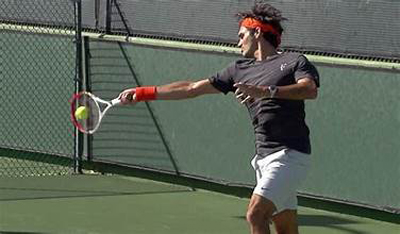
Over decades and generations, as talented players evolve and reach the top of the game, they can often change the way coaches view technique and how other players want their style to be, the way Borg, who is from Sweden, influenced Spanish tennis. Another example of technical cross-pollination is when Roger Federer burst on the scene and reached the top of the world. Players and coaches noticed how long he held his gaze through the impact of his shots. Other players started copying that technique and coaches started teaching the Federer style to their players.
But because players and coaches around the world have different favorite players and styles, they often disagree about philosophy, how to build technique, or what the final vision of world-class technique should look like.
Coaching leaders and coaching education organizations also have a big effect on how technique is shaped in countries around the world and often these two forces combine to form the education and training methods in their respective regions. The educators who write the textbooks and manuals and create curriculums for courses and presentations, can shape the technical philosophy of the coaches who they train and certify.
A New Factor: Science
Biomechanical analysis and modern sports science research can also help separate the wheat from the chaff in technical training. As discussed in the introduction, high-speed video analysis, kinematics, and kinetics are revolutionizing the way coaches and sports scientists understand technique. Science can play a crucial role helping coaches and players discern whether their intuition about a technique is good or bad.
Biomechanical principles can help create reasonable technical parameters that can serve as guardrails that allow innovation and individual style to flourish within scientifically prescribed boundaries. They play a critical role in the modern era to shed light on the dark ages of technique, learning and teaching, and to help form an evidenced-based model of ideal technique.
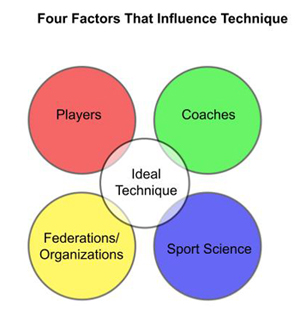
What About the "Naturals?"
The interplay between players, coaches, federations/teaching organizations, and sport science research profoundly shape techniques around the world, but some athletes will always be "naturals"--like Borg--who learn and hit intuitively without lessons or guidance.
A natural is a genius player who intuitively develops world-class technique on his or her own, and these individuals are the subject of wonder and appreciation by many in the tennis world.
We all seem to be jealous of naturals in any field because they quickly learn skills that others struggle with. Naturals sometimes have technique that are unorthodox but work for the player. The problem for naturals is that they are extremely rare and for every genius player who does it his or her own way like Borg did, there are many athletes who trust their own instincts and fail or get themselves hurt.
Player instincts are a double-edged sword: occasionally a player "intuitively" knows what's best, but often what the player feels is wrong and counterproductive. Unfortunately some players believe they are naturals when they are really not. I believe players and coaches need to use sport science and high-speed video to provide parameters of effective techniques, and players themselves should intuitively discover within those guidelines what feels best for them.
As highlighted in the first article (Click Here), the Winning Pretty method argues that, with effective evidence-based parameters in place, players can safely use intuition to guide them without unintended catastrophic results.
What Are the Ideal Techniques?
Before recent advances in modern high-speed video and biomechanical analysis, three of those factors—coaches, players, and federations/organizations, which are influenced by favoritism, bias, and regional style--caused endless controversy and debate about what is the optimal way to hit the ball and move on the tennis court.
Today, sport science can help bridge philosophical divides and offers an unbiased way to analyze technique and prove that certain methods are better than others. Still it's a running joke that at tennis educational conferences, if you put a hundred coaches in a room to talk about technique, you are going to get a hundred opinions about the best way to hit the ball, just as it was at the beginning of the game.
The Winning Pretty philosophy and method strive to be as unbiased as possible, rooted in sport science, and guided by high-speed video analysis. Still at the end of the day, coaches have to decide what elements to stress with players of different ages and levels of development.
These articles and the book to follow present my take on all of these issues.



